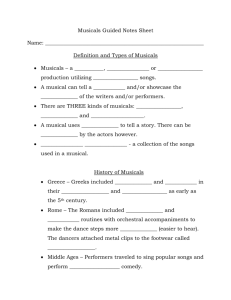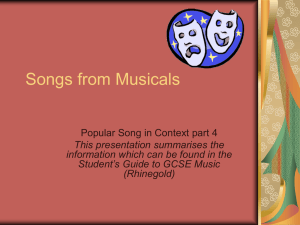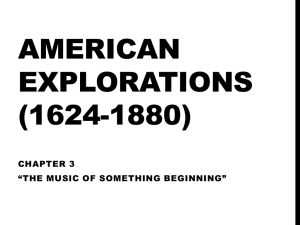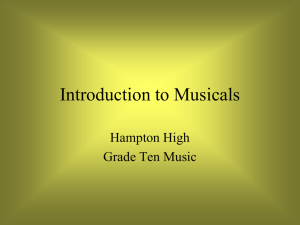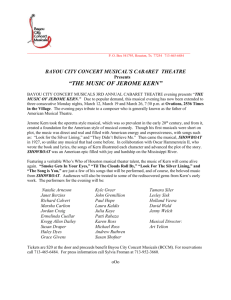Musical Theatre History
advertisement
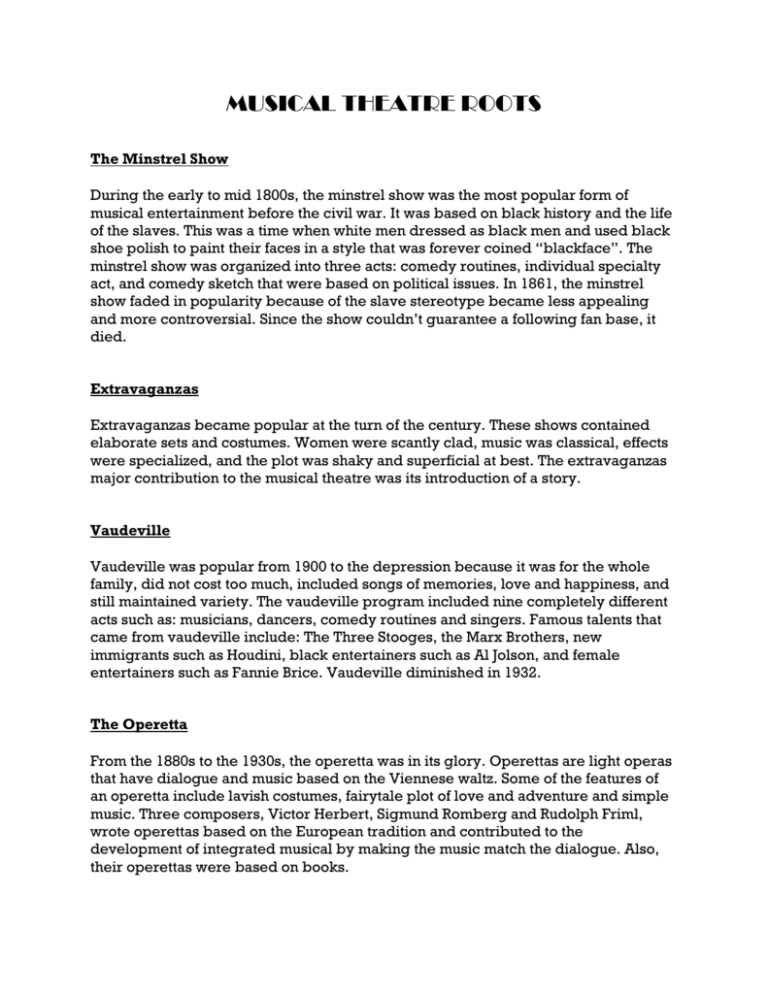
MUSICAL THEATRE ROOTS The Minstrel Show During the early to mid 1800s, the minstrel show was the most popular form of musical entertainment before the civil war. It was based on black history and the life of the slaves. This was a time when white men dressed as black men and used black shoe polish to paint their faces in a style that was forever coined “blackface”. The minstrel show was organized into three acts: comedy routines, individual specialty act, and comedy sketch that were based on political issues. In 1861, the minstrel show faded in popularity because of the slave stereotype became less appealing and more controversial. Since the show couldn’t guarantee a following fan base, it died. Extravaganzas Extravaganzas became popular at the turn of the century. These shows contained elaborate sets and costumes. Women were scantly clad, music was classical, effects were specialized, and the plot was shaky and superficial at best. The extravaganzas major contribution to the musical theatre was its introduction of a story. Vaudeville Vaudeville was popular from 1900 to the depression because it was for the whole family, did not cost too much, included songs of memories, love and happiness, and still maintained variety. The vaudeville program included nine completely different acts such as: musicians, dancers, comedy routines and singers. Famous talents that came from vaudeville include: The Three Stooges, the Marx Brothers, new immigrants such as Houdini, black entertainers such as Al Jolson, and female entertainers such as Fannie Brice. Vaudeville diminished in 1932. The Operetta From the 1880s to the 1930s, the operetta was in its glory. Operettas are light operas that have dialogue and music based on the Viennese waltz. Some of the features of an operetta include lavish costumes, fairytale plot of love and adventure and simple music. Three composers, Victor Herbert, Sigmund Romberg and Rudolph Friml, wrote operettas based on the European tradition and contributed to the development of integrated musical by making the music match the dialogue. Also, their operettas were based on books. The Spectacular Revue Reaching its peak during the 1920 and 30s, the spectacular revue featured fast pace entertainment, glamorous costumes and sets, the “All American Girl”, leading entertainers, and large and elaborate musical scores. The most famous producer of the spectacular revue was Florenz Ziegfeld, creating Ziegfeld Follies. Musical Comedy A full length musical comedy was first introduced by George Cohan, a composer and entertainer who pioneered the first musical theatre libretto (book musical), bridging the gap between drama and music, operetta and extravaganza. His musical The Honeymooners still plays on Broadway to this day. The Intimate Revue This revue show is different from the spectacular revue because it consists of a smaller company, wittier songs, and a challenging context (plot or subject matter). These shows were not as elaborate, but great talents such as Bob Hope, Ethel Murman, Cole Porter, and George Gershwin made up for it and were main contributors to the success of the intimate revue. Broadway Irving Berlin, Cole Porter, and George Gershwin made the transition from revue to Broadway by writing the music for popular musicals such as Kiss Me Kate, Annie Get Your Gun and Porgy and Bess. The Integrated Musical Broadway musicals changed direction: the plot (libretto) became the most important element. Everything relates back to the plot to compliment the story. Jerome Kern did this best when he produced Show Boat (1927), with subject matter that was serious and songs that reflected the plot. Other producers and their integrated musicals include: Lorenze Heart’s Pal Joey and On Your Toes; and Oscar Hammerstein’s Oklahoma, Carousel and South Pacific. Book Musical and Choreography The 1950s saw an outpouring of book musicals: Guys and Dolls, My Fair Lady, West Side Story, The King and I. Also, choreography started to play a larger role in telling the story or reflecting upon mood or setting. This fusion between song, dance and drama required a versatile director; and therefore, talented directors were often monopolized. The first great choreographer/director was Gerome Robins who directed On The Town, The King and I, West Side Story, Gypsy, Fiddler on the Roof, and more. These were concept musicals that provided metaphorical imagery. Concept musicals focus on an idea rather than a plot. For example, A fiddler on a roof, playing soft music without falling was a metaphor for the current Jewish life: gracefully on the cusp of tragedy. Concept musicals are typically the kind that last because its ideas and themes are powerfully motivating and timeless. After a conventional career start in the sixties, Bob Fosse created Pippin, Chicago, and Dancin’. These shows were innovative because they had a no-nonsense style and disregarded the storyline to focus on dancing. Gower Champion, a dancer before turning to staging musicals, invented the “beehive” set, where actors stay in their own cubical area even during choreography. For example, in Bye Bye Birdie, he created the staircase routine and the street number, both of which were mimicked in later shows such as Hello Dolly! and 42nd Street. Rock Musical Rock musicals incorporate the popular rock music genre into its plot. Musicals like Hair (first rock musical) and Grease differ in tone and structure from past musicals because they express their stories through dance and song over lines. These musicals spoke to rebellious audiences and were adapted in tone to stay fresh with the times (1970s). They brought excitement and popular music to the stage with flashy visual effects to parallel rock concerts. There was a carefree tone and structure. Composers of rock music, like Tim Rice, Andrew Lloyd Webber and Steven Shwarts, were some of the very few to write for the Broadway theatre. This is due to the fact that most rock music artists were already so busy with their own bands and touring. Shows like Jesus Christ Superstar and Godspell were rock musicals that caused controversy over associating a sacred religious story to rock and roll music. Some thought it was wrong to relate religion to rebellion; however, teens and educators claimed it allowed for a better understanding of the story. Interesting Facts A Chorus Line is the longest running and most successful musical in Broadway history because everyone can identify with the struggle of being the best at something, the choreography is relied upon more so than the book, and it’s a behind the scenes look at a part of Broadway. Les Miserable and Phantom of the Opera differ from the earlier traditional book musicals because they are opera based musicals. The evolution of the black musical began with white musicals featuring black performers (Purlie) to revivals done with all-black casts (Guys and Dolls, Hello Dolly) to all-black musical productions (Raisin and Dream Girls, and The Wiz). New Musicals – List off as many as you can think of from the 1980-present
